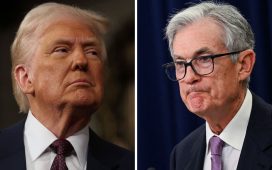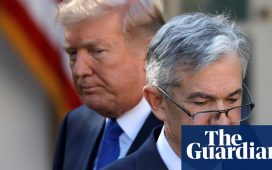Unlock the Editor’s Digest for free
Roula Khalaf, Editor of the FT, selects her favourite stories in this weekly newsletter.
This article is an on-site version of our Unhedged newsletter. Sign up here to get the newsletter sent straight to your inbox every weekday
Good morning. Ethan here; Rob is out. This week is a big one: inflation numbers on Tuesday will be shortly followed by a Federal Reserve meeting the next day. Fed officials appear genuinely divided on how to read the economy, with a few open to rate rises while Fed governor Chris Waller talks about cuts. Jay Powell’s job is rarely ever so hard, or so interesting. Email me: ethan.wu@ft.com.
Calling for recession is contrarian now
At the start of 2023, it was banal to forecast a near-term recession. Today, it’s a risky call. Most economists now see a soft landing as the likeliest way this cycle ends, for good reason. Inflation keeps surprising to the downside. Consumption has powered through high rates. Behind it all is a rock-solid labour market, which added another 200,000 net jobs in November, 50,000 above consensus estimates. As Claudia Sahm argued in our latest Friday interview, supply improvements foiled recession calls.
Nonetheless, a few stragglers on Wall Street remain in the recession camp. And though their arguments proved wrong earlier this year, they are worth considering, if only to understand the risks to the soft landing. With that in mind, where does the case for recession stand?
For Don Rissmiller, economist at Strategas, his 50 per cent recession probability estimate (versus 40 per cent for a soft landing) comes from an unease with the soft landing story. He nicely sums up why:
There remain 5 key elements of the current US soft-landing story that we can’t yet fully subscribe to: 1) The economy can take higher interest rates & grow indefinitely; 2) The lagged effects of prior policy & bank tightening have been fully digested; 3) Continued US unemployment < 4% will be accompanied with acceptable wage inflation; 4) The local labour market is moving to a state of balance by cutting only job openings vs. jobs; 5) Markets (bonds, equities, housing, etc) can easily handle higher interest rates lasting from here.
The affirmative case for a (mild) recession was recently made by Matthew Luzzetti, Deutsche Bank’s chief US economist, a longstanding recessionista. He makes three broad points. First, tighter financing is weighing on consumer spending through higher delinquencies and business investment through reduced capex. Luzzetti’s measure of manufacturers’ capex intentions, drawn from regional Fed surveys, is verging on contraction territory. Some broader measures, such as real private-sector equipment investment in the GDP data, are already shrinking year over year, in line with tight financial conditions:

Second, fiscal policy is acting against growth. In 2023, fiscal spending either added to or mildly subtracted from growth, but in 2024 it is likely to shave some 0.6 percentage points off headline real GDP growth, according to a Brookings Institution measure. That is in keeping with projections that the US fiscal deficit will shrink next year, in part due to higher expected revenue from capital gains taxes.
Third, underlying trend inflation is not necessarily stabilising at 2 per cent, limiting how many pre-emptive rate cuts the Fed can do. Luzzetti notes that several Fed measures of underlying inflation are closer to 3 per cent, and have stopped rapidly declining:

Nomura’s US economists, Aichi Amemiya and Jeremy Schwartz, share Luzzetti’s view of the risks to business investment from tight financial and credit conditions. They add another point: labour market strength may be overstated. They note several signs of declining labour demand, including falling job openings, more surveyed workers saying jobs are “hard to get” and the rising duration of unemployment-benefit use.
What about the relentless pace of job growth? After Friday’s payroll report, the US economy appears to have gained 186,000 jobs for each of the past six months, including an average of 175,000 in October and November. That is well above the 75,000 or so needed to keep up with baseline population growth. But Amemiya and Schwartz argue that after excluding the effects of recent autoworker and Hollywood strikes, which lift payroll gains as striking workers re-enter employment, the past two months of payroll gains drop to 120,000. Six-month average monthly job growth is probably closer to 130,000, calculates Omair Sharif of Inflation Insights, still strong but suggesting less of a job market buffer.
Lastly, JPMorgan’s Marko Kolanovic, who is not in the recession camp but believes recession risk is underestimated, reminds us that the yield curve is still inverted. Recessions have nearly always followed inversions historically, but with a lag time up to two years. That window extends through the back half of 2024, meaning that higher recession risk would be consistent with history. Kolanovic wrote last week:
. . . it is becoming consensus thinking that a recession will be avoided. We see the arguments such as no landing, goldilocks, election year seasonality, labour market resiliency, uprating of valuations, Fed put, etc, as various versions of “this time is different.” Going back to basics and the relatively small number of recessions we can study — signalling from yield curve inversion indicates that recession risk is highest between 14 and 24 months following the onset of inversion. That period will cover most of 2024 .
These arguments, especially Kolanovic’s point about the yield curve, need to be tempered with a recognition that this supply-dominated cycle looks different. Supply disruptions and the goods-to-services spending shift were largely responsible for inflation’s rise, and improvements in labour supply for its fall, making the historical record an imperfect guide.
Still, Wall Street’s last few recession holdouts are highlighting a real weakness in the soft landing story: that it requires everything to go right simultaneously. In particular, softening in business investment and low-end consumption need to stay contained while the labour market returns to normal. But with the ratio of job vacancies to unemployed workers still 12 per cent higher than 2019 levels, it will take at least a few more months to normalise — enough time for something to go wrong. The consensus bet on soft landing is a good one, but by no means bulletproof.
One good read
Scary-sounding numbers on massive organised shoplifting in the US are just wrong?
FT Unhedged podcast

Can’t get enough of Unhedged? Listen to our new podcast, hosted by Ethan Wu and Katie Martin, for a 15-minute dive into the latest markets news and financial headlines, twice a week. Catch up on past editions of the newsletter here.








